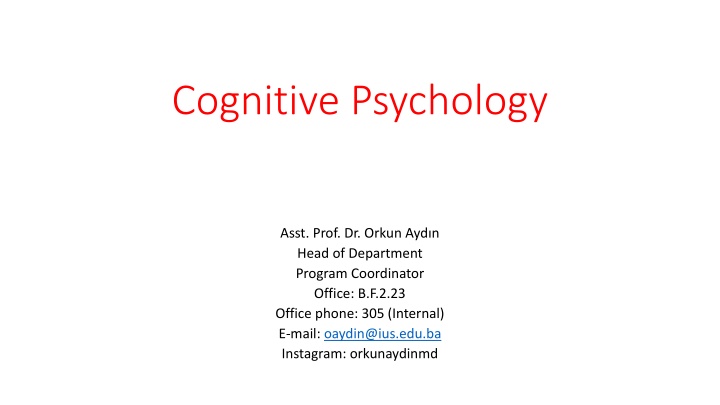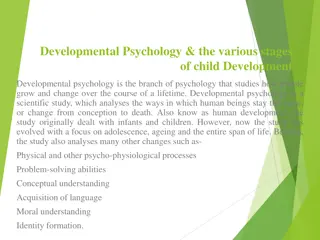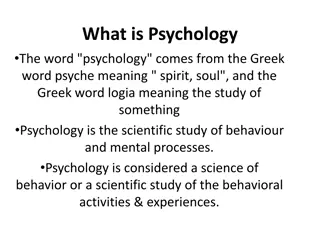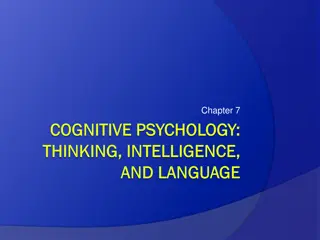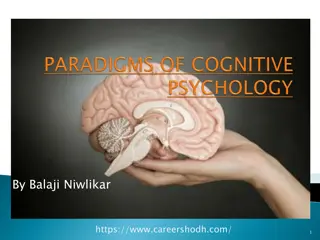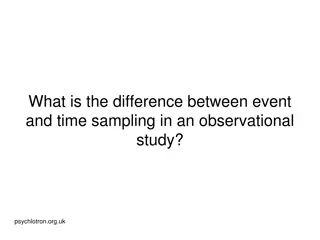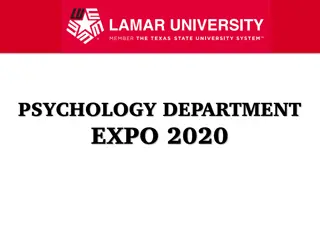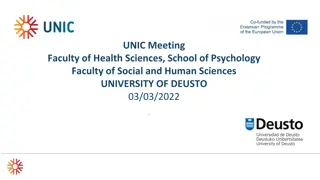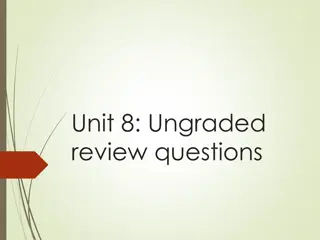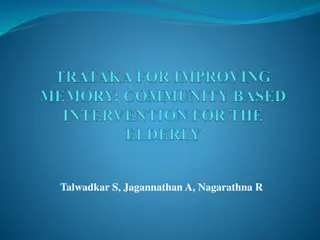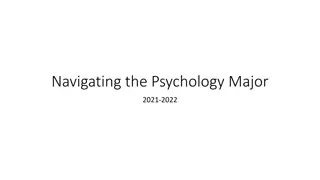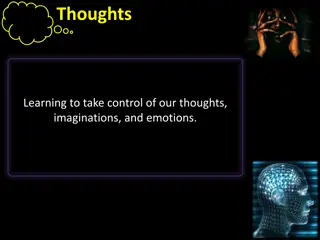A Day in the Life: Thoughts and Actions of a Cognitive Psychology Student
As Tom goes through his daily routine, he visualizes, perceives, and recalls various aspects of his environment and tasks at hand. From remembering a book to considering transportation options, he demonstrates cognitive processes such as attention, memory, and decision-making. This snapshot offers insights into how perception, memory, knowledge, and awareness come into play in our everyday lives.
Download Presentation

Please find below an Image/Link to download the presentation.
The content on the website is provided AS IS for your information and personal use only. It may not be sold, licensed, or shared on other websites without obtaining consent from the author.If you encounter any issues during the download, it is possible that the publisher has removed the file from their server.
You are allowed to download the files provided on this website for personal or commercial use, subject to the condition that they are used lawfully. All files are the property of their respective owners.
The content on the website is provided AS IS for your information and personal use only. It may not be sold, licensed, or shared on other websites without obtaining consent from the author.
E N D
Presentation Transcript
Cognitive Psychology Asst. Prof. Dr. Orkun Ayd n Head of Department Program Coordinator Office: B.F.2.23 Office phone: 305 (Internal) E-mail: oaydin@ius.edu.ba Instagram: orkunaydinmd
Visualizes book on desk Understands conversation Thinks Be on time for appointment. Remembers Susan s book Thinks about car problem Perceives campus scenes
Daily routine Tom is walking across campus, talking to Susan on his cell phone about meeting at the student union later this afternoon, he remembers that he left the book she had lent him at home: T: I can t believe it, I can see it sitting there on my desk, where I left it. I should have put it in my backpack last night when I was thinking about it.
As he finishes his call with Susan and makes a mental note to be on time for their appointment, He suddenly remembers his car is scheduled to go into the service. He thinks other options: 1)Renting a car offers the most mobility, but is expensive. 2)Bumming rides from his roommate is cheap, but limiting. 3)Learning the bus schedules from student union he decides.
Entering his cognitive psychology class, he remembers that an exam is coming up soon. Unfortunately, he still has a lot of reading to do, so he decides that he won t be able to take Susan to the movies tonight, as they had planned, because he needs time to study. As the lecture begins, Tom is feeling anxiety, fear while thinking about his meeting with Susan.
This is one of the example of someones daily routine So what did Raphael do during this short span of time?
Perception Perceives his environment seeing people on campus and hearing Susan talking on the phone Attention Pays attention to one thing after another the person approaching on his left, what Susan is saying, how much time he has to get to his class Memory Remembers something from the past that he had told Susan he was going to return her book today Knowledge Distinguishes items in a category, when he thinks about different possible forms of transportation rental car, roommate s car, bus
Visual Imagery Visualizes the book on his desk the night before Language Understands and produces language as he talks to Susan Problem solving Works to solve a problem, as he thinks about how to get places while his car is in the service Reasoning and Decision Making Makes a decision, when he decides to postpone going to the movies with Susan so he can study
Who is responsible for this? All of the Raphael s actions belong to his MIND!! Cognitive psychology is the branch of psychology concerned in the scientific study of the mind.
We will learn: What the mind is, How it has been studied, What researchers have discovered about mind working
What is the mind? The mind creates and controls mental functions such as perception, attention, memory, emotions, language, deciding, thinking, and reasoning. This reflects the mind s central role in determining our various mental abilities, which we will learn this semester.
The mind is a system that creates representations of the world so that we can act within it to achieve our goals. This definition reflects the mind s importance for functioning and survival.
Association The first definition indicates different types of cognition the mental processes such as perception, attention, memory, and so on, that are what the mind does. The second definition indicates something about how the mind operates (it creates representations) and its function (it enables us to act and to achieve goals).
It It is is no acting acting to to achieve no coincidence coincidence that achieve goals that all goals. . all of of the the cognitions cognitions in in the the first first definition definition play play important important roles roles in in Mind functioning: Cognitive roles: Perception Attention Creating respresantations Memory Language Organizing roles
The beauty of the mind is not used for only extraordinary things Even the most routine things: recognizing a person, having a conversation, or deciding what courses to take next semester But it becomes amazing when we consider the properties of the mind that enable us to achieve these familiar activities.
So. the mind creates cognition and it is important for functioning and survival The cognitive psychology is about answering this question: Determining the properties and identifying the underlying mechanisms of the mind.
The first experiment in Cognitive Psychology Franciscus Donders (physiologist)-1868 How long does it take to make a DECISION?
What is the experiment? He searched the answer by measuring reaction time, how long it takes to respond to presentation of a stimulus. In the first part of his experiment, he asked his participants to press a button upon presentation of a light. This is called a simple reaction time task.
Second part In the second part of the experiment, he made the task more difficult by presenting two lights: one on the left and one on the right. The participants task in this part of the experiment was to push one button when the light on the left was illuminated and another button when the light on the right was illuminated. This is called a choice reaction time task.
Modern version of reaction time task (a) Press J when light goes on. (b) Press J for left light, K for right
Light flashes Left light flashes Stimulus REACTION TIME Perceive the light Perceive left light Mental response Decide which button to push Press key Press J key Behavioral response *Donders measured reaction time, the time between presentation of the light and the participant s response.
The diagram for the choice reaction time task shows that the mental response includes not only perceiving the light but also deciding which button to push. Donders reasoned that choice reaction time would be longer than simple reaction. So the difference in reaction time between the simple and choice conditions would indicate how long it took to make the decision.
Why it is important? It took one-tenth of a second to decide which button to push The first cognitive psychology experiment however no one knows what is the term (it was not coined-invented until 1967) In the 1800s, ideas about the mind were dominated by the belief that it is not possible to study the mind so this scientist opposed and came across this wisdom.
This experiment found that: He was measuring the relationship between the presentation of the stimulus and the participant s response(the reaction time). He did not measure the mental response directly, but inferred how long it took from the reaction times. For all research in cognitive psychology mental responses (perceiving the light and deciding which button to push, in this example) cannot be measured directly, but must be inferred from behavior.
Ebbinghauss Ebbinghaus s Memory Experiment Memory Experiment Ebbinghaus was interested in determining the nature of memory and forgetting specifically, how information that is learned is lost over time. He presented nonsense syllables such as DAX, QEH, LUH, and ZIF to himself one at a time, using a device called a memory drum (modern cognitive psychologists would use a computer). He used nonsense syllables so that his memory would not be influenced by the meaning of a particular word.
LUH (b) Repeat. Predict what next syllables in list will be, until remember all items correctly. (a) View series of nonsense syllables. LUH (c) After delay, repeat step b.
He repeated the procedure, going through the list and trying to remember each syllable in turn, until he was able to go through the list without making any errors. He noted the number of trials it took him to do this. After learning a list, Ebbinghaus waited, for delays ranging from almost immediately after learning the list to 31 days.
The memory loss curve Ebbinghaus s savings (or forgetting) percent savings as a measure of the amount remembered, Ebbinghaus plotted this against interval between initial learning and testing. curve. Taking the the time
Ebbinghaus found that: The memory drops rapidly for the first 2 days after the initial learning and then levels off. This curve was important because it demonstrated that memory could be quantified. Notice that although Ebbinghaus s method was very different from Donders reaction time method, both measured behavior to determine a property of the mind.
Little Albert Experiment (1920) Albert, a 9-month-old-boy, subjected to a loud noise every time a rat (which Albert had originally liked before) came close to the child. After a few pairings of the noise with the rat, Albert reacted to the rat by crawling away as rapidly as possible.
SKINNERS OPERANT CONDITIONING(1938) SKINNER S OPERANT CONDITIONING(1938) Behavior is strengthened by the presentation of positive reinforcers, such as food or social approval or withdrawal of negative reinforcers, such as a shock or social rejection.
Psychologists conditioning to things like applied the techniques of classical and operant a) classroom teaching, b) treating psychological disorders, c) and testing the effects of drugs on animals.
Tolmans Rat Maze Experiment C C C D D D B B B A A A (a) Explore maze (c) Turn left for food (b) Turn right for food (a) Rat initially explores the maze; (b) the rat learns to turn right to obtain food at B when it starts at A (c) when placed at C the rat turns left to reach the food at B. In this experiment, precautions are taken to prevent the rat from knowing where the food is based on cues such as smell.
What is interesting about that? Tolman s explanation of this result was that when the rat initially experienced the maze it was developing a cognitive map, a conception of the maze s layout (Tolman, 1948). Thus, even though the rat had previously learned to turn right, when the rat was placed at C, it used its map to turn left at the intersection to reach the food at B. Tolman s use of the word cognitive, and the idea that something other than stimulus-response connections might be occurring in the rat s mind.
Timeline Other researchers were aware of Tolman s work, but for most American psychologists in the 1940s, the use of the term cognitive was difficult to accept because it violated the behaviorists idea that internal processes, such as thinking or maps in the head, were not acceptable topics to study.
The Rebirth of The Study of The Mind The decade of the 1950s is generally recognized as the beginning of the cognitive revolution. a shift in psychology from the behaviorist s stimulus-response relationships to an approach whose main thrust was to understand the operation of the mind.
These events provided a new way to study the mind, called the information-processing approach One of the events that inspired psychologists to think of the mind in terms of information processing was a newly introduced device called the digital computer.
First computer The first digital computers, developed in the late 1940s, were huge machines that took up entire buildings, but in 1954 IBM introduced a computer that was available to the general public. They found their way into university research laboratories, where they were used both to analyze data and, most important for our purposes, to suggest a new way of thinking about the mind.
Flow diagram of a basic computer Input Arithmetic unit Input processor Memory unit Output Figure shows the layout of a computer in which information is received by an input processor and is then stored in a memory unit before it is processed by an arithmetic unit, which then creates the computer s output.
The first study under this approach One of the first experiments influenced by this new way of thinking about the mind involved studying how well people are able to pay attention to only some information when a lot of information is being presented at the same time.
How well the mind can deal with incoming information? When a number of auditory messages are presented at once (as might occur at a noisy party, for example), can a person focus on just one of these messages (as when you are having a conversation with one of the people at the party)?
Cherrys Attention Experiment The yellow dog chased... The meaning of life is... The yellow dog chased...
The importance of the experiment .is that presented to one ear, and when they did, they were aware of little of the message being presented to the other,unattended ear. people could focus their attention on the message This result led another British psychologist, (1958), to propose the first flow diagram of the mind. Donald Broadbent This diagram represented what happens in a person s mind as he or she directs attention to one stimulus in the environment.
Broadbents Flow Diagram Input Input Input Filter Detector To memory Input It was the first to depict the mind as processing information in a sequence of stages.
Example from daily routine Applied to your experience when talking to a friend at a noisy party, the filter lets in your friend s conversation and filters out all of the other conversations and noise. Thus, although you might be aware that there are other people talking, you would not be aware of detailed information, such as what the other people were talking about.
